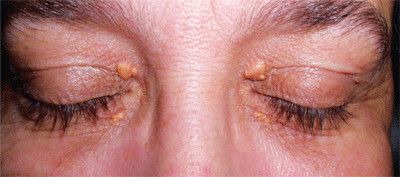If you’re seeing lipid-containing yellow plaques—also known as xanthelasmata—on the eyelids, your patient could be looking at a higher risk of cardiovascular disease, according to a study in the September 15 issue of BMJ.

The lipids found in xanthelasmata, as seen in this patient, are derived from
lipoproteins found in plasma. Courtesy: Klaus D. Peter, Gummersbach, Germany.
Researchers made the link after analyzing data from the Copenhagen City Heart Study, which began in 1976 and included 12,745 participants. At baseline, 4.4% of patients exhibited xanthelasmata and 24.8% showed arcus corneae. Individuals with either condition had higher total cholesterol, LDL cholesterol, triglycerides and apolipoprotein B.
The researchers concluded that subjects who had xanthelasmata at baseline had an adjusted hazard ratio for myocardial infarction of 1.48, as well as an increased risk of ischemic heart disease and death.
“The results from this study suggest that xanthelasmata are a cutaneous marker of atherosclerosis independent of lipid concentrations, and thus, should be considered in clinical practice as an independent and additional risk factor for myocardial infarction and ischemic heart disease,” wrote Anne Tybærg-Hansen, M.D., of Rigshospitalet in Copenhagen, and colleagues.
Christoffersen M, Frikke-Schmidt R, Schnohr P, et al. Xanthelasmata, arcus corneae, and ischemic vascular disease and death in general population: Prospective cohort study. BMJ 2011; DOI:10.1136/bmj.d5497.

